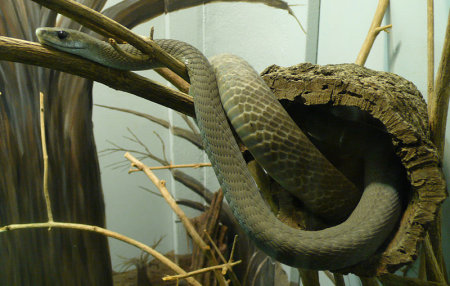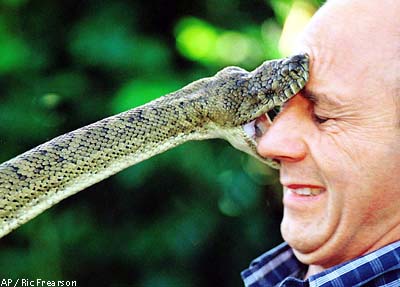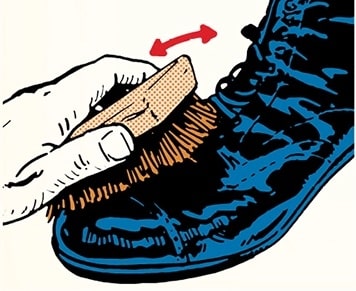
You and your buddies are out on a camping trip reconnecting with nature and your masculinity. You’re taking a day hike to see some ancient Indian hieroglyphics, when all of sudden you feel the acute pain of two razor sharp fangs entering your flesh. You’ve just been bitten by a snake. Do you know what to do?
Just the sight of a slithering snake can send a shiver down even the manliest spine. And with good reason-with just one nibble, and in only a few hours, these feetless, cold-blooded serpents can snuff out your life. While only 9-15 people in the United States die every year from snake bites, if you don’t know how to treat them correctly, you or your loved one could become part of those statistics. Knowing how to deal with snakes and snakebites is essential man knowledge.
The best way to “treat” a snakebite is to avoid getting bitten in the first place. So in Part 1 of the Art of Manliness’ Guide to Snakes, we’ll give you a dossier on all the bad boys you need to look out for.
In Part 2, we’ll discuss ways to avoid becoming some snake’s snack and how to treat a bite if you do get bitten.
Know Your Enemy
If you were a Boy Scout, you were probably taught an old mnemonic to help you identify venomous snakes:
Red and black, friend of Jack. Red and yellow, kill a fellow.
Or in other words, if a snake has adjacent red and black colors on its skin, it’s not venomous. If red and yellow are adjacent, that snake is venomous.
But as a man, you’re past simple maxims. You want to know how to identify and name a snake. You want to know the habits of your nemeses. So, here’s a description of the various poisonous snakes found in North America and around the world.
Coral Snake
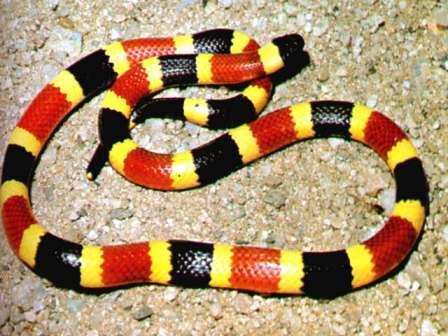
Know Thine Enemy: Coral snakes are easy to spot by their distinctive coloring. They have alternating, red, yellow, and black bands. Did you get that? Red and yellow are touching each other, meaning this bad boy is poisonous. Be on the look out. There are counterfeit corals that have alternating red, black, and yellow bands. These aren’t poisonous.
Coral snakes are shorter than other venomous snakes. They average about 40 inches and have smaller mouths and fangs.
Their hideout: Corals are found in the southern and eastern United States, and in other places around the world. They can usually be found slithering in dry areas with lots of shrubs. They frequently spend their time underground or buried under leaf litter, and don’t pop out to say hello very often. You’ll see them most frequently after it rains or during breeding season. There are also some aquatic species that loiter in your favorite swimming hole.
How mean are they? They’re not aggressive or prone to biting, but if they do bite-watch out. Their venom takes longer to deliver, so when they bite, they hold on and won’t let go.
Rattlesnakes
Rattlesnakes are easy to identify because, well, they have a rattle at the end of their tail. When threatened, the rattlesnake shakes its rattle as a warning to his would-be nemeses. Luckily for us, it’s a pretty damn loud warning; its peak frequency is equivalent to that of an ambulance siren. Did you ever wonder what a rattlesnake’s rattle was made of? Yeah? Me too. It’s basically composed of modified scales that slough off from the tail. Each time a rattlesnake sheds its skin, a new segment is added. When the snake shakes its tail in the air, the segments rattle against each other. Contrary to popular belief you can’t tell a rattlesnake’s age from counting the number of rattle segments; while they do add more segments on a regular basis, they also lose them during travels. Word of warning: if the rattle gets soaked from wet weather, it will no longer emit its noisy warning. So tread lightly in those conditions.
Several varieties of rattlesnakes exist and their habitats range from Canada to South America. The diamondback rattlesnake, the mojave rattlesnake, the sidewinder rattlesnake, and the timber rattlesnake are three species common to the United States
The Diamondback Rattlesnake
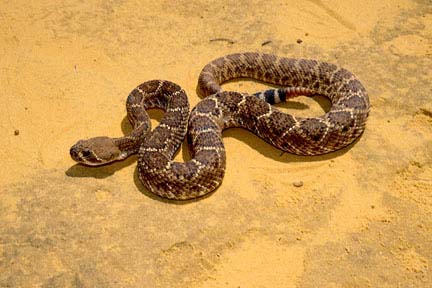
Know Thine Enemy: The different species of rattlesnakes have varied colorings, but all can be identified by their skin’s telltale diamond pattern. Most diamondbacks are about 3.5-5.5 feet long, although the Eastern diamondbacks, the biggest of the bunch, have been found in the 7 ft range.
Their hideout: Diamondbacks are generally found along the southern border of the United States, from Florida to Baja California and into Mexico. Rattlesnakes like to sun themselves and come out in the early morning or afternoon to bask in the sun’s rays. You therefore often find them sunning themselves on rocky ledges. While not typically adept climbers, species like the eastern diamond back have been found 32 ft off the ground. Some are excellent swimmers as well; eastern diamondbacks slither for miles in-between islands in the Florida Keys.
How mean are they? Some diamondbacks will retreat if given a chance. But often they will stand their ground and may strike repeatedly. They can strike from a distance up to 2/3 their body size and strike faster then the human eye can see, so stay as far away as possible. They have some of the fiercest venom of any snake; victims can die within hours of being bitten.
The Mojave Rattlesnake
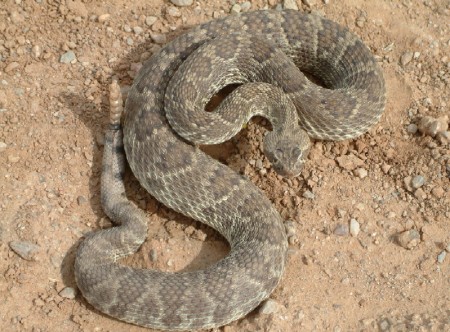
Know Thine Enemy: Generally 3-4.5 ft long, it has grayish diamond shape markings on its back like the diamondback, but it’s overall coloration is more green than brown.
Their hideout: The mojave rattlesnake primarily lives in the desert of the southwestern United States, so be on the look out for it when you’re riding a burro down the Grand Canyon.They are common in wide expanses of desert and can often be found near scrub brush. They hibernate during the winter.
How mean are they? Although there isn’t scientific date to back it up, mojaves have a reputation for being quite aggressive, especially towards people.
The Sidewinder Rattlesnake
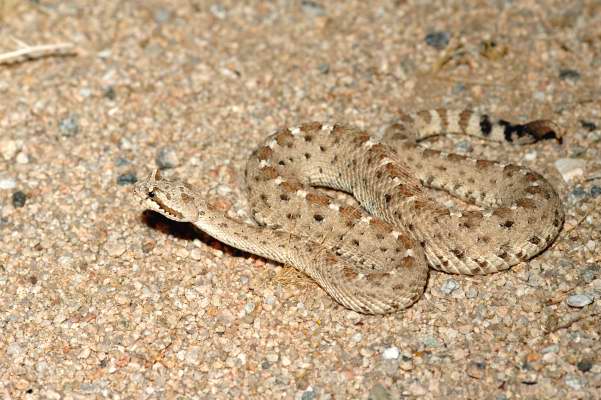
Know Thine Enemy: The sidewinder gets its name from its trademark sideways locomotion. The reason they do this is to reduce the amount of contact they have with the hot desert sands and to increase their movement’s efficiency. Just watching this thing move puts you on notice that it’s a killing machine. Smaller than its rattling cousins, the sidewinder usually is 1.5-2 feet long. The sidewinder is light in color with darker bands on its back. In addition to its trippy sideways movement, evolution has given the sidewinder another killer advantage: it can survive in the desert without a single drop of water. They get all the water they need from the prey they devour. That’s right. When a sidewinder sees you walking along, you’re not only lunch, but also a canteen. Watch out.
Their hideout: These snakes can be found in the desert of the southwestern United States and northern Mexico. During the cooler months (about December to February) the sidewinder is nocturnal. They are diurnal the rest of the year.
How mean are they? Their venom is weaker than their cousins, but still can cause a serious health threat. Tread lightly.
Timber Rattlesnake
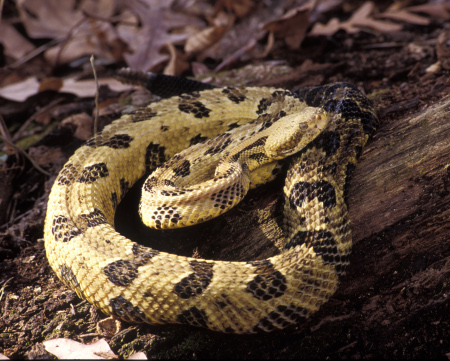
Know Thine Enemy: Timber rattlesnakes have a yellow, brown, and rust orange coloring and are typically 3-4 ft in length. The timber rattler was immortalized during the American Revolution where it served as the symbol in the “Don’t Tread on Me Flag.” It also serves as the First Navy Jack.
Their hideout: Unlike many of its rattlesnake cousins who live in the deserts of the West, the timber rattlesnake is found in the eastern United States; it’s the only rattlesnake to make its home in the Northeast.
How mean are they? Timber rattlers are a much mellower breed of rattlesnakes, so they don’t bite too often. And they tend to rattle a lot before striking, giving you time to hightail it out of there.
Cottonmouth Snakes

Know Thine Enemy: The Cottonmouth is one scary snake. No one wants to see it slithering toward them at their favorite watering hole. Cottonmouth snakes are usually around 2 ft in length, although some have grown to a size of nearly 6 ft. Their brown, gray, tan, yellowish olive or blackish coloring, is segmented by dark crossbands. When threatened, cottonmouths will throw their head back and open their mouth wide, displaying the white interior from whence it derives the name “cottonmouth.”
Their hideout: The cottonmouth is an aquatic snake found in the south and southeast part of the United States. Cottonmouths make creeks, streams, marshes, and lakes their home, although they can also be found on dry land. Because of their affinity to water, cottonmouths are also known as water moccasins. Cottonmouths can be active during the day and night. But when it’s hot, they are usually found coiled or stretched out in the shade.
How mean are they? Despite their vicious reputation, in many cases the cottonmouth’s hiss is worse than its bite. Cottonmouths often engage in a showy threat display without attacking. This routine includes shaking their tail and letting a musky secretion rip from their anal glands. The scent of this snake fart has been compared to that of a billy goat; so if you smell goat, flee in the other direction.
Copperhead Snakes

Know Thine Enemy: Copperhead snakes are identified by their coppery colored head and neck. Adults reach lengths of 2 to 4 feet.
Their hideout: Copperheads are mainly found in the eastern part of the U.S. They make forest and woodlands their home. However, they do prefer to live closer to water.
How mean are they? Copperheads will only bite if they feel directly threatened, i.e., if you try to pick up or touch them. But this contact can happen inadvertently. Unlike many venomous snakes that usually slither away when humans are around, copperheads will freeze in place, often resulting in humans stepping on them and getting bitten. A bite from a copperhead is extremely painful but is not fatal if treated properly.
Cobras
Cobras are probably the most famous of all the venomous snakes, thanks in part to Johnny and the gang at Cobra Kai Dojo in the Karate Kid. (I hate Johnny. What a prick.) Several species of cobras exist. What they all have in common is the distinct “hood” they make when they are threatened. In order to create this distinct cobra hood, cobras will flatten their body by spreading their ribs.
The King Cobra
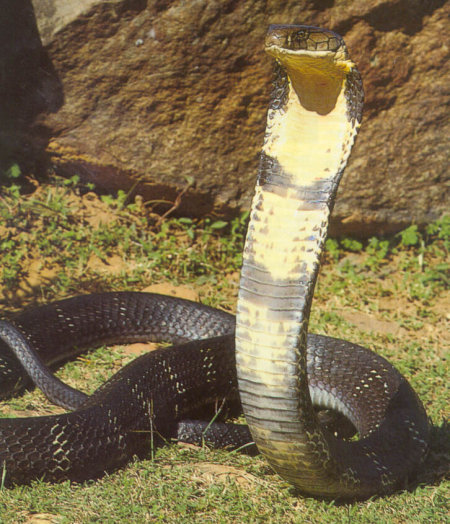
Know Thine Enemy: The King Cobra is the world’s longest venomous snake, growing to a length of between 12 and 13 feet Wowza! Their olive green, tan, or black skin has pale yellow cross bands down the length of the body.
Their hideout: King Cobras are found in South and Southeast Asia. They can also be found in some parts of India. King Cobras typically live in dense highland forests near rivers and streams.
How mean are they? The King Cobra is one scary mother. The King Cobra doesn’t just feed on small rodents, this bad boy is cannibalistic- it eats other snakes. While the King Cobra is shy, it will attack if it is provoked. The venom from a King Cobra consists of extremely potent neurotoxins that attack the victim’s central nervous system. A single bite from a King Cobra can kill a full grown Asian Elephant. It can kill a man in half an hour.
The Red Spitting Cobra
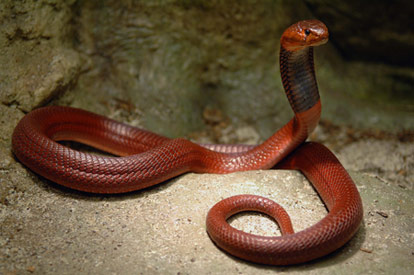
Know Thine Enemy: Red Spitting Cobras vary in color from red to gray. They can grow to about 4 feet in length. What makes this cobra unique is its ability to “spit” or project their venom at their prey. Watch out!
Their hideout: Red Spitting Cobras are native to Africa are most common in that continent’s northeast region. They make their homes in brush and forests. The red spitting cobra is nocturnal, so make sure you zip up your tent!
How mean are they? Like the King Cobra, the Red Spitting Cobra is a timid and shy snake and will only attack when threatened. Unlike the King Cobra with its ultra toxic venom, the Red Spitting Cobra’s venom is much milder. While it may cause extreme sickness, a bite from a Red Spitting Cobra will probably not cause death. However, if the venom gets in your eyes and is not treated quickly, it can cause blindness so still take caution.
The Black Mamba Snake
Know Thine Enemy: The black mamba is the largest and most deadly snake in Africa. It also happens to be the fastest moving snake in the world. In short, this snake is a killing machine. The Black Mamba gets its name not from the fact that it has black skin, but because it is black on the inside of its mouth. The skin of a black mamba is actually gray to olive green. Black mambas can grow to a length of between 7 and 13 feet.
Their hideout: Black mambas make their home in the grasslands of Africa. You can find them primarily in the Democratic Republic of Congo.
How mean are they? Black Mambas are mean mothers. They will readily attack when threatened. They’ll make multiple attacks, aiming at the head and body. With each bite, they inject their super deadly venom. One bite from a black mamba has enough venom to kill 120-140 men. The venom paralyzes the muscles used for breathing and the victim consequently dies from suffocation.
An important note: While all this “enemy” language is in good fun, snakes actually play a vital role in our ecosystem. Without them, vermin and critters of many kinds would overrun us. These tips should help you avoid snakes, not seek them out for destruction. Unless it’s a do or die situation, leave the snake alone and move in the other direction.


